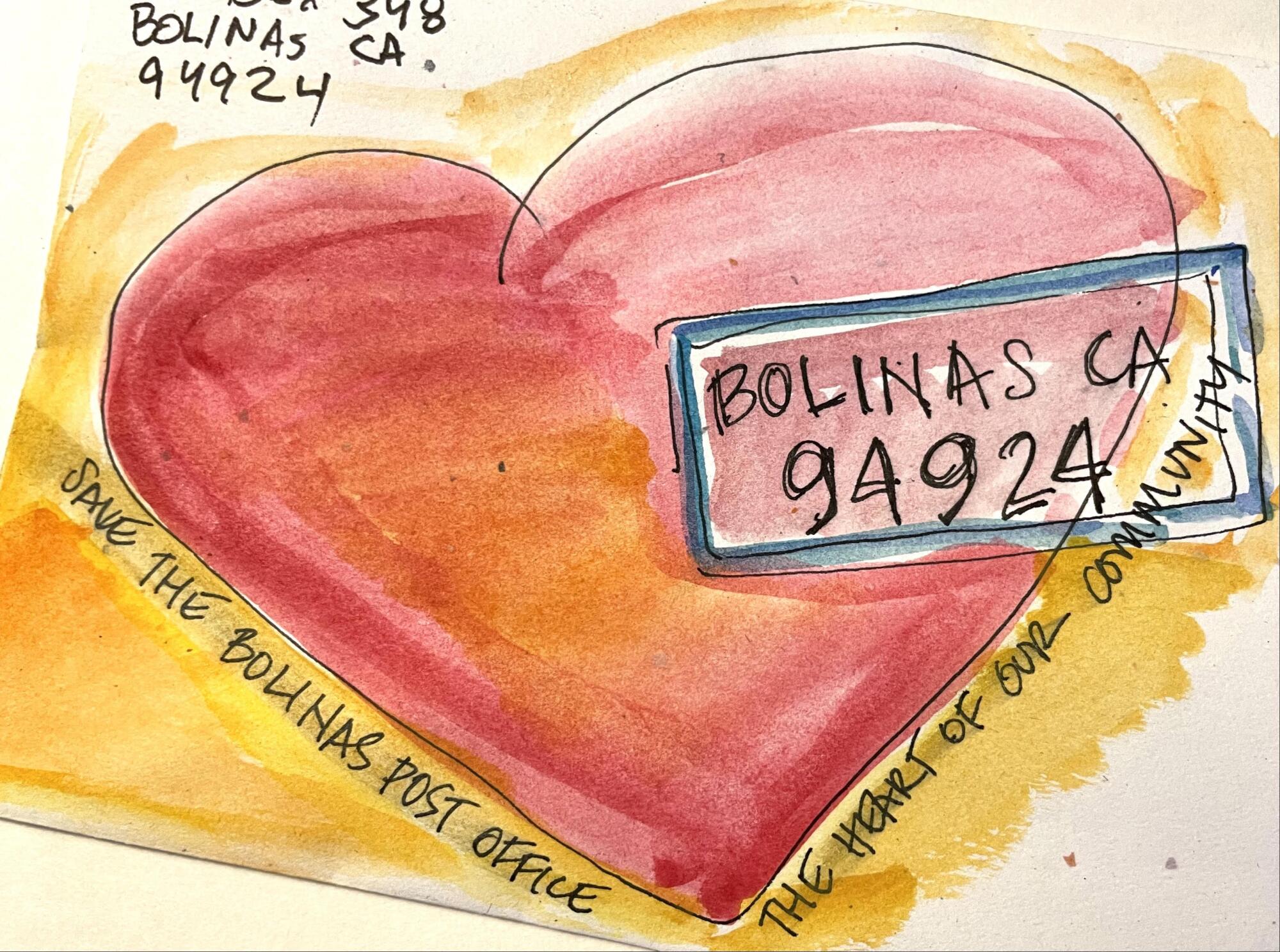Business
Dear USPS: This California town wants its post office back

On the outskirts of this coastal village — just past the road sign telling visitors they are “Entering a Socially Acknowledged Nature-Loving Town” — a big wooden placard displays a set of hand-painted numbers. They are changed each morning.
“Days Without a Bolinas Post Office,” the sign reads.
On June 1, that number hit 456.
That’s how long it has been since the U.S. Postal Service was booted from its office in downtown Bolinas amid a fight with its longtime landlord.
In this artsy little town in west Marin County — a haven for poets and painters, writers and actors — the loss hit hard. The 1,500 citizens of ZIP Code 94924 have fought to get their post office back with their most cherished tool: creativity.
They have picketed with placards reading, “Real Mail Not Email!” They have marched in local parades dressed as letter carriers. They have composed songs and written poems and sent thousands of letters, in hand-painted envelopes, to USPS officials.
They even drafted their own plan for a temporary post office, offered to fund it, and sent it to Congress.
“It’s a very Bolinas approach, breaking through bureaucracy through art and culture and pleas,” said John Borg, who is helping lead the citizens campaign. “This has taken way longer than it should.”
The approach is quirky, but the loss is serious.
A sign at the entrance of Bolinas counts the days the small coastal town has been without its post office.
(Genaro Molina / Los Angeles Times)
Most people in this aging rural community abutting the Point Reyes National Seashore do not get home delivery. They relied upon daily trips to the post office for parcels, pension checks and mail-order prescriptions, not to mention the chance to catch up on the small-town scuttlebutt.
Now, they must drive at least 40 minutes round-trip, through the forest on Highway 1, to a flood-prone post office at a campground in the even smaller town of Olema.
Enzo Resta, a longtime resident and founder of the new Bolinas Film Festival, compared reaction to the loss of the post office with the so-called “hype cycle” around new technologies.
“There was the crash, where there was a lot of hope and indicators we would get it back — the peak of inflated expectations,” he said. “When it got pushed a little further, we kind of went into the valley of despair, and we’re just trying to crawl back out.”
The Bolinas post office shut down on March 3, 2023. It had occupied half of an unadorned single-story wooden building on Brighton Avenue — most recently shared with a liquor store — for six decades.
The USPS already was a tenant when Gregg Welsh, of Ventura County, acquired the building about 50 years ago. His family trust currently owns it.
The relationship between landlord and tenant soured long ago.

Most people in Bolinas do not get home delivery and relied upon daily trips to the post office for their parcels, pension checks and mail-order prescriptions.
(Genaro Molina / Los Angeles Times)
According to a statement provided by Welsh through his attorney, Patrick Morris, the USPS for years violated its lease, which required it to maintain and repair the flooring at its own expense.
The postal service, the statement reads, discovered asbestos in the floor tiles in 1998, but essentially kept it hidden from the landlord for more than two decades and did not post warning signs for the public or employees.
When Welsh visited the Bolinas post office in late 2020, the statement reads, he saw worn and broken tiles and exposed, deteriorating subfloor materials.
The landlord and the postal service tussled over who should pay for repairs and asbestos abatement.
The USPS lease, according to the statement, ended in January 2022, with the parties still arguing over the floor. The postal service continued to occupy the building, sans lease, as a “tenant at sufferance.”
In a February 2023 email to USPS officials, which Morris provided to The Times, Morris said his client had not yet evicted the post office, in part because he had not wanted to deprive Bolinas residents of postal facilities before it could find a new location. But at that point, Welsh had had enough. He demanded the post office vacate the building within a month.
Kristina Uppal, a Bay Area-based spokeswoman for the USPS, did not respond to questions from The Times about accusations made by the landlord or about the alleged presence of asbestos in the building. She said the USPS was “forced from the old facility due to the unexpected termination of a lease,” but that there are no plans to permanently close the Bolinas post office.
“We are just as eager to resume retail operations in Bolinas as the community and provide enhanced accessibility such as expanding street delivery to alleviate any inconvenience,” Uppal wrote.

Bolinas residents sent more than 2,500 “art” letters with personalized appeals asking U.S. Postal Service officials to resurrect mail service in their town.
(John Borg)
Residents want their post office back, but their trust in the USPS has frayed.
The dust-up in Bolinas comes as U.S. Postmaster Louis DeJoy, appointed when former President Trump was in the White House, is under fire for efforts to consolidate postal facilities. In a May letter, a bipartisan group of U.S. senators criticized his 10-year plan, Delivering for America, arguing that cost-cutting measures have degraded service and disproportionately affected rural communities.
Bolinas residents say they have had little direct communication from the USPS over the last 15 months. Bolinas, they note, had a post office since 1863, but townsfolk were given less than two weeks’ notice before it closed.
Their mail has been bounced around — rerouted first to Olema, then to nearby Stinson Beach because of flooding, then back to Olema. Sometimes, their letters were left in unsecured bins on outdoor tables.
The relocation has been more than just an inconvenience for the town’s elderly residents, many of whom cannot drive. There is little public transit, and more than half the town’s residents are 65 or older.
People began reporting problems getting mail-order medication soon after the post office closed, according to the Marin County Board of Supervisors. They also have struggled to get lab results and healthcare coverage updates.
Borg, 62, is a type 1 diabetic who had his insulin delivered through the mail before the closure. Now, he said, package delivery is so iffy that he drives two hours round-trip to San Rafael each month to pick it up at a pharmacy.

Bolinas’ poets and painters have been integral to the town’s campaign for a post office. Here, an artist who goes by StuArt, creates the sign that will count the days Bolinas goes without service.
(John Borg)
Borg runs a small business, making stainless steel drinkware, and has had two five-figure checks for his company lost in the mail.
He said residents of the unincorporated town — which has no mayor or city attorney advocating on their behalf — had to band together to make their voices heard.
Appealing to the outside world is a tall order for a place so famously reclusive that, for years, a vigilante band called the Bolinas Border Patrol stole road signs on Highway 1 directing travelers into town. Once, when the California Department of Transportation tried painting BOLINAS on the blacktop, sneaky citizens promptly blacked them out with tar.
“We’re a small village that kind of likes to keep to ourselves and deflect attention and not be super profile. But we’re in the process where the town is changing,” said Borg, noting that a growing share of Bolinas’ limited housing stock is being used as second homes for the wealthy and short-term vacation rentals.
“The one thing that holds this place together is the post office.”
There has been no viable commercial real estate in tiny Bolinas for the post office to move into permanently. And a 1971 water meter moratorium has effectively prohibited development for the last 53 years. The moratorium, which has been challenged and upheld in court, was put into place because Bolinas has a limited water supply, mostly coming from the Arroyo Hondo Creek in the Point Reyes National Seashore.
Last spring, residents drafted a detailed proposal for a temporary facility — a mobile office trailer on a parking lot next to the fire station — and offered to raise $50,000 for its installation.

Bolinas residents note they were given just two weeks’ notice that their post office — a fixture in town since 1863 — was closing.
(Genaro Molina / Los Angeles Times)
They sent the plan to a supportive Rep. Jared Huffman (D-San Rafael), who shipped it to DeJoy. A spokesperson for Huffman said his office has been in frequent contact with the USPS and shares the community’s frustration over the slow process.
Uppal, the USPS spokeswoman, said the agency has “reviewed proposals” and “will select a site that best meets our operational needs and can provide continued service to the community long term.”
“I can confirm there is a potential option that is under review now,” she wrote. She did not provide details.
In his written response to questions from The Times, Welsh, through his attorney, said there has been discussion with USPS about moving back into its former building. No further details were provided.
For now, Bolinas residents continue to haul up to Olema — and to lionize the simple pleasure of picking up their mail locally. Or, as one local poet put it in an ode penned for a “Save the Post Office” rally:
I have gossip to send to Tomales,
regrets to send to Limantour Beach.
But it’s Bolinas — always Bolinas — I dream of finding
in the return address of a letter sent to me.

Business
U.S. Space Force awards $1.6 billion in contracts to South Bay satellite builders

The U.S. Space Force announced Friday it has awarded satellite contracts with a combined value of about $1.6 billion to Rocket Lab in Long Beach and to the Redondo Beach Space Park campus of Northrop Grumman.
The contracts by the Space Development Agency will fund the construction by each company of 18 satellites for a network in development that will provide warning of advanced threats such as hypersonic missiles.
Northrop Grumman has been awarded contracts for prior phases of the Proliferated Warfighter Space Architecture, a planned network of missile defense and communications satellites in low Earth orbit.
The contract announced Friday is valued at $764 million, and the company is now set to deliver a total of 150 satellites for the network.
The $805-million contract awarded to Rocket Lab is its largest to date. It had previously been awarded a $515 million contract to deliver 18 communications satellites for the network.
Founded in 2006 in New Zealand, the company builds satellites and provides small-satellite launch services for commercial and government customers with its Electron rocket. It moved to Long Beach in 2020 from Huntington Beach and is developing a larger rocket.
“This is more than just a contract. It’s a resounding affirmation of our evolution from simply a trusted launch provider to a leading vertically integrated space prime contractor,” said Rocket Labs founder and chief executive Peter Beck in online remarks.
The company said it could eventually earn up to $1 billion due to the contract by supplying components to other builders of the satellite network.
Also awarded contracts announced Friday were a Lockheed Martin group in Sunnyvalle, Calif., and L3Harris Technologies of Fort Wayne, Ind. Those contracts for 36 satellites were valued at nearly $2 billion.
Gurpartap “GP” Sandhoo, acting director of the Space Development Agency, said the contracts awarded “will achieve near-continuous global coverage for missile warning and tracking” in addition to other capabilities.
Northrop Grumman said the missiles are being built to respond to the rise of hypersonic missiles, which maneuver in flight and require infrared tracking and speedy data transmission to protect U.S. troops.
Beck said that the contracts reflects Rocket Labs growth into an “industry disruptor” and growing space prime contractor.
Business
California-based company recalls thousands of cases of salad dressing over ‘foreign objects’

A California food manufacturer is recalling thousands of cases of salad dressing distributed to major retailers over potential contamination from “foreign objects.”
The company, Irvine-based Ventura Foods, recalled 3,556 cases of the dressing that could be contaminated by “black plastic planting material” in the granulated onion used, according to an alert issued by the U.S. Food and Drug Administration.
Ventura Foods voluntarily initiated the recall of the product, which was sold at Costco, Publix and several other retailers across 27 states, according to the FDA.
None of the 42 locations where the product was sold were in California.
Ventura Foods said it issued the recall after one of its ingredient suppliers recalled a batch of onion granules that the company had used n some of its dressings.
“Upon receiving notice of the supplier’s recall, we acted with urgency to remove all potentially impacted product from the marketplace. This includes urging our customers, their distributors and retailers to review their inventory, segregate and stop the further sale and distribution of any products subject to the recall,” said company spokesperson Eniko Bolivar-Murphy in an emailed statement. “The safety of our products is and will always be our top priority.”
The FDA issued its initial recall alert in early November. Costco also alerted customers at that time, noting that customers could return the products to stores for a full refund. The affected products had sell-by dates between Oct. 17 and Nov. 9.
The company recalled the following types of salad dressing:
- Creamy Poblano Avocado Ranch Dressing and Dip
- Ventura Caesar Dressing
- Pepper Mill Regal Caesar Dressing
- Pepper Mill Creamy Caesar Dressing
- Caesar Dressing served at Costco Service Deli
- Caesar Dressing served at Costco Food Court
- Hidden Valley, Buttermilk Ranch
Business
They graduated from Stanford. Due to AI, they can’t find a job

A Stanford software engineering degree used to be a golden ticket. Artificial intelligence has devalued it to bronze, recent graduates say.
The elite students are shocked by the lack of job offers as they finish studies at what is often ranked as the top university in America.
When they were freshmen, ChatGPT hadn’t yet been released upon the world. Today, AI can code better than most humans.
Top tech companies just don’t need as many fresh graduates.
“Stanford computer science graduates are struggling to find entry-level jobs” with the most prominent tech brands, said Jan Liphardt, associate professor of bioengineering at Stanford University. “I think that’s crazy.”
While the rapidly advancing coding capabilities of generative AI have made experienced engineers more productive, they have also hobbled the job prospects of early-career software engineers.
Stanford students describe a suddenly skewed job market, where just a small slice of graduates — those considered “cracked engineers” who already have thick resumes building products and doing research — are getting the few good jobs, leaving everyone else to fight for scraps.
“There’s definitely a very dreary mood on campus,” said a recent computer science graduate who asked not to be named so they could speak freely. “People [who are] job hunting are very stressed out, and it’s very hard for them to actually secure jobs.”
The shake-up is being felt across California colleges, including UC Berkeley, USC and others. The job search has been even tougher for those with less prestigious degrees.
Eylul Akgul graduated last year with a degree in computer science from Loyola Marymount University. She wasn’t getting offers, so she went home to Turkey and got some experience at a startup. In May, she returned to the U.S., and still, she was “ghosted” by hundreds of employers.
“The industry for programmers is getting very oversaturated,” Akgul said.
The engineers’ most significant competitor is getting stronger by the day. When ChatGPT launched in 2022, it could only code for 30 seconds at a time. Today’s AI agents can code for hours, and do basic programming faster with fewer mistakes.
Data suggests that even though AI startups like OpenAI and Anthropic are hiring many people, it is not offsetting the decline in hiring elsewhere. Employment for specific groups, such as early-career software developers between the ages of 22 and 25 has declined by nearly 20% from its peak in late 2022, according to a Stanford study.
It wasn’t just software engineers, but also customer service and accounting jobs that were highly exposed to competition from AI. The Stanford study estimated that entry-level hiring for AI-exposed jobs declined 13% relative to less-exposed jobs such as nursing.
In the Los Angeles region, another study estimated that close to 200,000 jobs are exposed. Around 40% of tasks done by call center workers, editors and personal finance experts could be automated and done by AI, according to an AI Exposure Index curated by resume builder MyPerfectResume.
Many tech startups and titans have not been shy about broadcasting that they are cutting back on hiring plans as AI allows them to do more programming with fewer people.
Anthropic Chief Executive Dario Amodei said that 70% to 90% of the code for some products at his company is written by his company’s AI, called Claude. In May, he predicted that AI’s capabilities will increase until close to 50% of all entry-level white-collar jobs might be wiped out in five years.
A common sentiment from hiring managers is that where they previously needed ten engineers, they now only need “two skilled engineers and one of these LLM-based agents,” which can be just as productive, said Nenad Medvidović, a computer science professor at the University of Southern California.
“We don’t need the junior developers anymore,” said Amr Awadallah, CEO of Vectara, a Palo Alto-based AI startup. “The AI now can code better than the average junior developer that comes out of the best schools out there.”
To be sure, AI is still a long way from causing the extinction of software engineers. As AI handles structured, repetitive tasks, human engineers’ jobs are shifting toward oversight.
Today’s AIs are powerful but “jagged,” meaning they can excel at certain math problems yet still fail basic logic tests and aren’t consistent. One study found that AI tools made experienced developers 19% slower at work, as they spent more time reviewing code and fixing errors.
Students should focus on learning how to manage and check the work of AI as well as getting experience working with it, said John David N. Dionisio, a computer science professor at LMU.
Stanford students say they are arriving at the job market and finding a split in the road; capable AI engineers can find jobs, but basic, old-school computer science jobs are disappearing.
As they hit this surprise speed bump, some students are lowering their standards and joining companies they wouldn’t have considered before. Some are creating their own startups. A large group of frustrated grads are deciding to continue their studies to beef up their resumes and add more skills needed to compete with AI.
“If you look at the enrollment numbers in the past two years, they’ve skyrocketed for people wanting to do a fifth-year master’s,” the Stanford graduate said. “It’s a whole other year, a whole other cycle to do recruiting. I would say, half of my friends are still on campus doing their fifth-year master’s.”
After four months of searching, LMU graduate Akgul finally landed a technical lead job at a software consultancy in Los Angeles. At her new job, she uses AI coding tools, but she feels like she has to do the work of three developers.
Universities and students will have to rethink their curricula and majors to ensure that their four years of study prepare them for a world with AI.
“That’s been a dramatic reversal from three years ago, when all of my undergraduate mentees found great jobs at the companies around us,” Stanford’s Liphardt said. “That has changed.”
-

 Iowa6 days ago
Iowa6 days agoAddy Brown motivated to step up in Audi Crooks’ absence vs. UNI
-

 Iowa1 week ago
Iowa1 week agoHow much snow did Iowa get? See Iowa’s latest snowfall totals
-

 Maine4 days ago
Maine4 days agoElementary-aged student killed in school bus crash in southern Maine
-

 Maryland6 days ago
Maryland6 days agoFrigid temperatures to start the week in Maryland
-

 Technology1 week ago
Technology1 week agoThe Game Awards are losing their luster
-

 South Dakota6 days ago
South Dakota6 days agoNature: Snow in South Dakota
-

 New Mexico4 days ago
New Mexico4 days agoFamily clarifies why they believe missing New Mexico man is dead
-

 Nebraska1 week ago
Nebraska1 week agoNebraska lands commitment from DL Jayden Travers adding to early Top 5 recruiting class




















